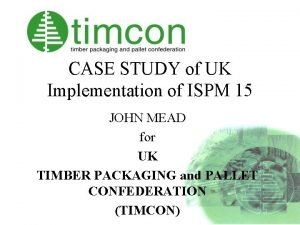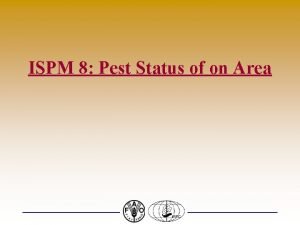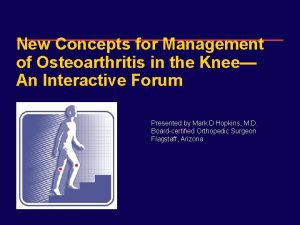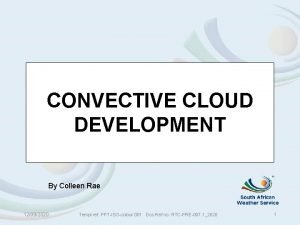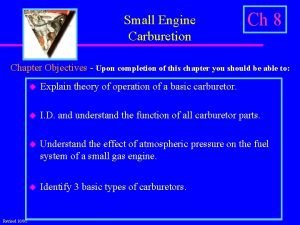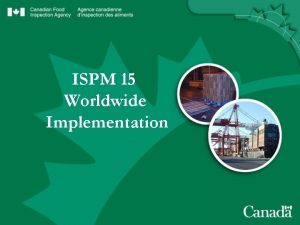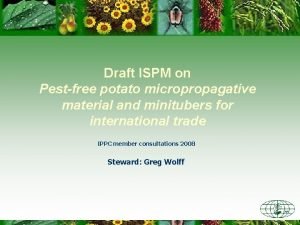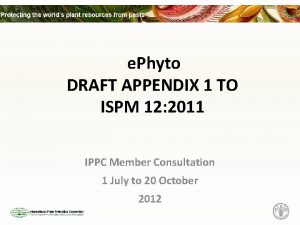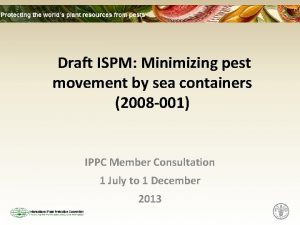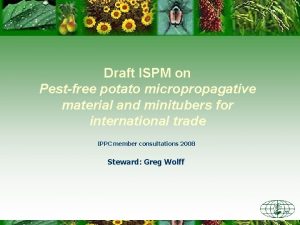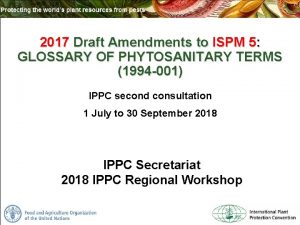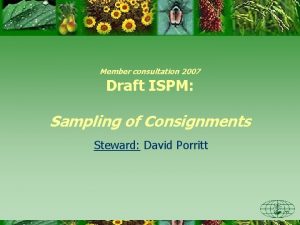DRAFT ISPM Revision of ISPM 8 Determination of









- Slides: 9

DRAFT ISPM: Revision of ISPM 8: Determination of pest status in an area (2009 -005) IPPC first consultation 1 July to 30 September 2018 IPPC Secretariat 2018 IPPC Regional Workshop

Background SC Nov • Recommended to add the topic to work programme (2009) CPM-5 (2010) • Added the topic Revision of ISPM 8 to work programme SC Nov 2013 • Approved Specification 59 EWG Sept 2017 • First draft produced SC May 2018 • Approved for 1 st consultation

General Considerations Reason for the revision Since adoption of ISPM 8 in 1998, new information and guidance became available, including new ISPMs on pest free areas and revision of ISPM 6 on Surveillance Pest records are common elements in these ISPMs Revised draft ISPM 8 describes the use of pest records and other information to determine pest status in an area

Scope This standard describes the use of pest records and other information to determine pest status in an area. Descriptions of pest status categories are provided, as well as recommendations for good reporting practices. This standard is not concerned with reporting obligations, but with the quality of information used in determining pest status.

Outline of Requirements 1. Pest status is determined by the NPPO responsible for the area 2. Guidance on evaluating the reliability of information is provided 3. Sources of uncertainty in determining the pest status in an area are described 4. This draft identifies and describes major categories for pest status 5. It provides guidance to NPPOs on responsibilities and reporting practices for determining and reporting pest status

Highlights of the revision Draft describes two main categories for pest status: “Presence” and “Absence” (Tables 1 & 2) Requirements for information on pest records are aligned with revised ISPM 6 (Surveillance) The ISPM addresses the quality of information in determining pest status but is not concerned with reporting obligations

Major drafting issues Pest categories • Two categories only: Present and Absent (no transient as a stand alone category, according to ISPM 5 definition) Relevant subcategories • Each Present and Absent category has seven subcategories with explanations • If no results of general or specific surveillance, or other information are provided to justify absence, the New requirements pest status can be considered “undetermined” (in alignment with newly revised ISPM 6) Quality of • Guidance on evaluating sources and quality of information for pest record is provided (Appendix 1).

Other relevant information The draft provides guidance on interpretation of pest interceptions in relation to pest status in an area The draft describes different cases where additional information about pest presence under limited conditions might be necessary Guidance on reliability of information sources used by NPPOs for determining pest status moved to Appendix 1 by the SC

Contacts IPPC Secretariat Food and Agriculture Organization of the United Nations Viale delle Terme di Caracalla, 00153 Rome, Italy Tel. : +39 -0657054812 Email: IPPC@fao. org Websites: www. fao. org www. ippc. int



